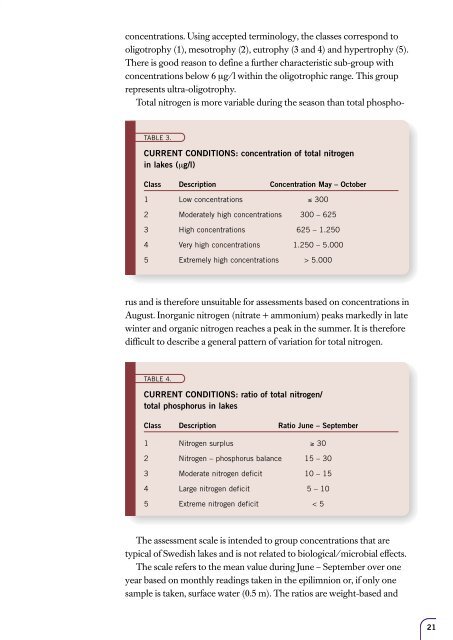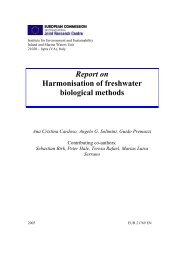Lakes and Watercourses
Lakes and Watercourses
Lakes and Watercourses
Create successful ePaper yourself
Turn your PDF publications into a flip-book with our unique Google optimized e-Paper software.
concentrations. Using accepted terminology, the classes correspond to<br />
oligotrophy (1), mesotrophy (2), eutrophy (3 <strong>and</strong> 4) <strong>and</strong> hypertrophy (5).<br />
There is good reason to define a further characteristic sub-group with<br />
concentrations below 6 µg/l within the oligotrophic range. This group<br />
represents ultra-oligotrophy.<br />
Total nitrogen is more variable during the season than total phospho-<br />
TABLE 3.<br />
CURRENT CONDITIONS: concentration of total nitrogen<br />
in lakes (µg/l)<br />
Class Description Concentration May – October<br />
1 Low concentrations ≤ 300<br />
2 Moderately high concentrations 300 – 625<br />
3 High concentrations 625 – 1.250<br />
4 Very high concentrations 1.250 – 5.000<br />
5 Extremely high concentrations > 5.000<br />
rus <strong>and</strong> is therefore unsuitable for assessments based on concentrations in<br />
August. Inorganic nitrogen (nitrate + ammonium) peaks markedly in late<br />
winter <strong>and</strong> organic nitrogen reaches a peak in the summer. It is therefore<br />
difficult to describe a general pattern of variation for total nitrogen.<br />
TABLE 4.<br />
CURRENT CONDITIONS: ratio of total nitrogen/<br />
total phosphorus in lakes<br />
Class Description Ratio June – September<br />
1 Nitrogen surplus ≥ 30<br />
2 Nitrogen – phosphorus balance 15 – 30<br />
3 Moderate nitrogen deficit 10 – 15<br />
4 Large nitrogen deficit 5 – 10<br />
5 Extreme nitrogen deficit < 5<br />
The assessment scale is intended to group concentrations that are<br />
typical of Swedish lakes <strong>and</strong> is not related to biological/microbial effects.<br />
The scale refers to the mean value during June – September over one<br />
year based on monthly readings taken in the epilimnion or, if only one<br />
sample is taken, surface water (0.5 m). The ratios are weight-based <strong>and</strong><br />
21















![Accommodation booking form [PDF]](https://img.yumpu.com/39471785/1/184x260/accommodation-booking-form-pdf.jpg?quality=85)

